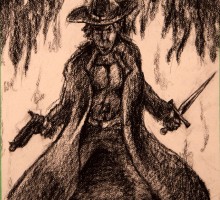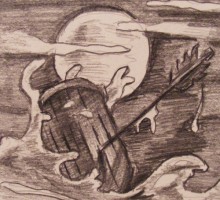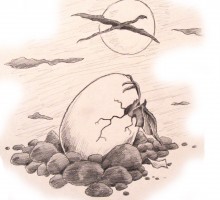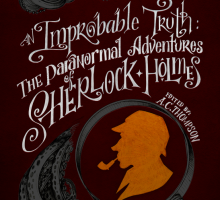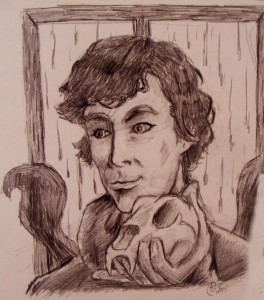Happy holidays! To celebrate, a nice dark cowboy image. 🙂 I’m working on StoneDragon (or the Dead Dragon Cowboy) tonight, right before wrapping up a few left-over kids presents, so thought it would be an appropriate image.
I’m going to talk now about one of the most impactful concepts that I’ve come across recently in my writing thoughts, one that I’ve spent some time mulling over and want to better apply in my own writing. It is the concept of writing following a clothesline, with various story elements tied to it, but an absolute need to keep that line of forward momentum.
Maybe a zip line would be a better analogy. You can tape setting, theme, description and other things to the wire, but you need that sense of purposeful movement that comes from sliding along it.
It’s a forward moving line, not a patchwork quilt where you don’t seem to be getting anywhere.
This concept can be credited to a couple of people, at least in my own research: Joshua Bilmes as recorded in one of Brandon Sanderson’s writing lessons, and Ilona Andrews, in describing how to deal with transitions (albeit in a slightly different context).
One of the points that this brings in is that description and detail should only included if they are directly relevant in time and significance to the main character in their immediate circumstances. Plot is the clothesline, other stuff can be strung along it, but it has to keep moving. You can’t stall in something that doesn’t have a sense of being relevant to the immediate story.
In other words, each paragraph should build on the one before and need the one after to fully realize the impact of the writing. As long as you keep this forward progression, you don’t need to rush. You can paint setting, give details, and help the reader to visualize the scene and understand your story.
The point is that readers want to feel a confident hand at the wheel. They want to make sure that everything that they are reading has a purpose and that they aren’t stuck in a morass of unimportant details that don’t lead anywhere. Especially for a new writer, that hasn’t earned their trust.
So keep things tied to the clothesline. Keep moving forward. And may that make all the difference for all of us!
Merry Christmas! May you have all the success you dream of in the New Year!!
